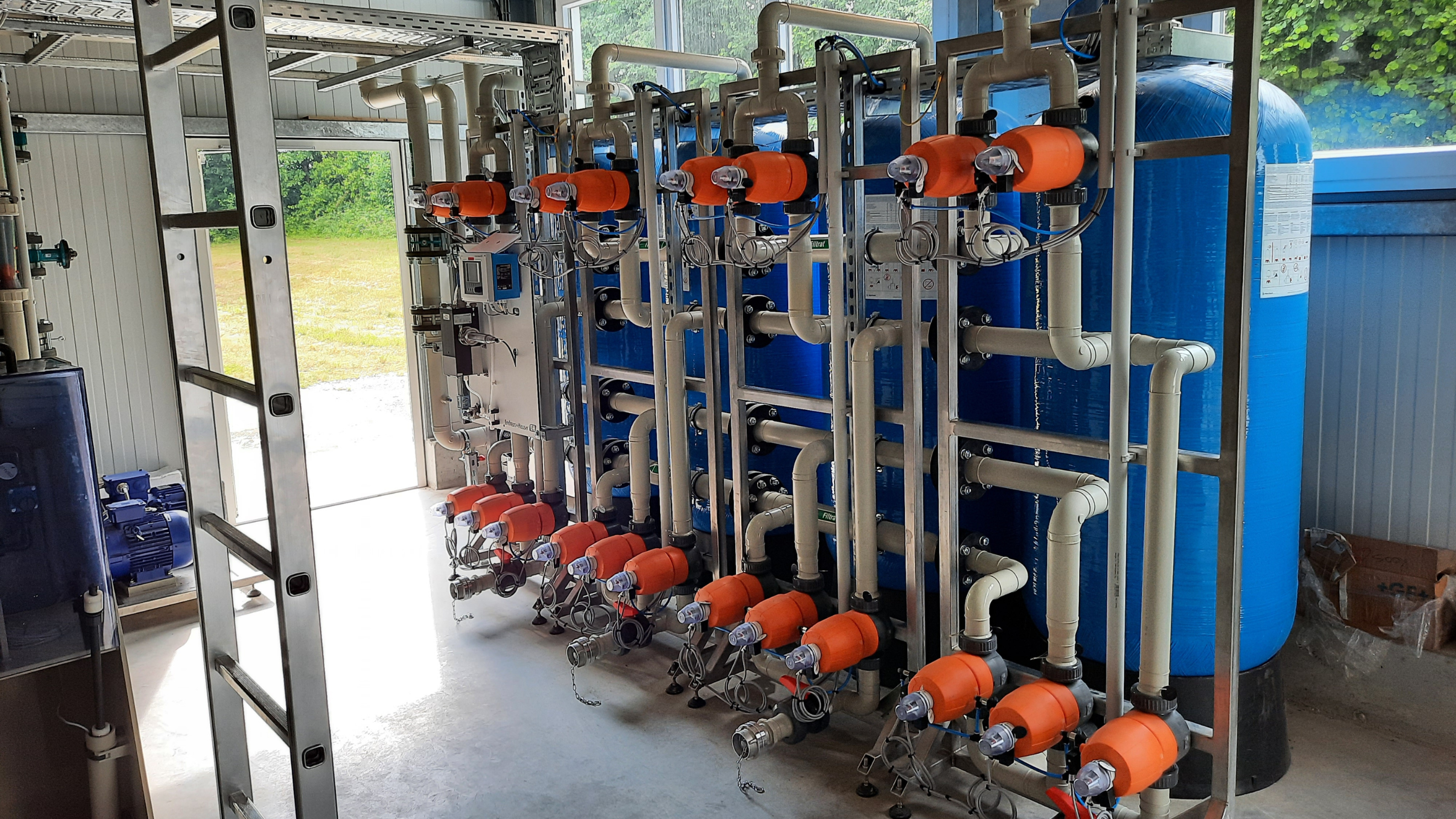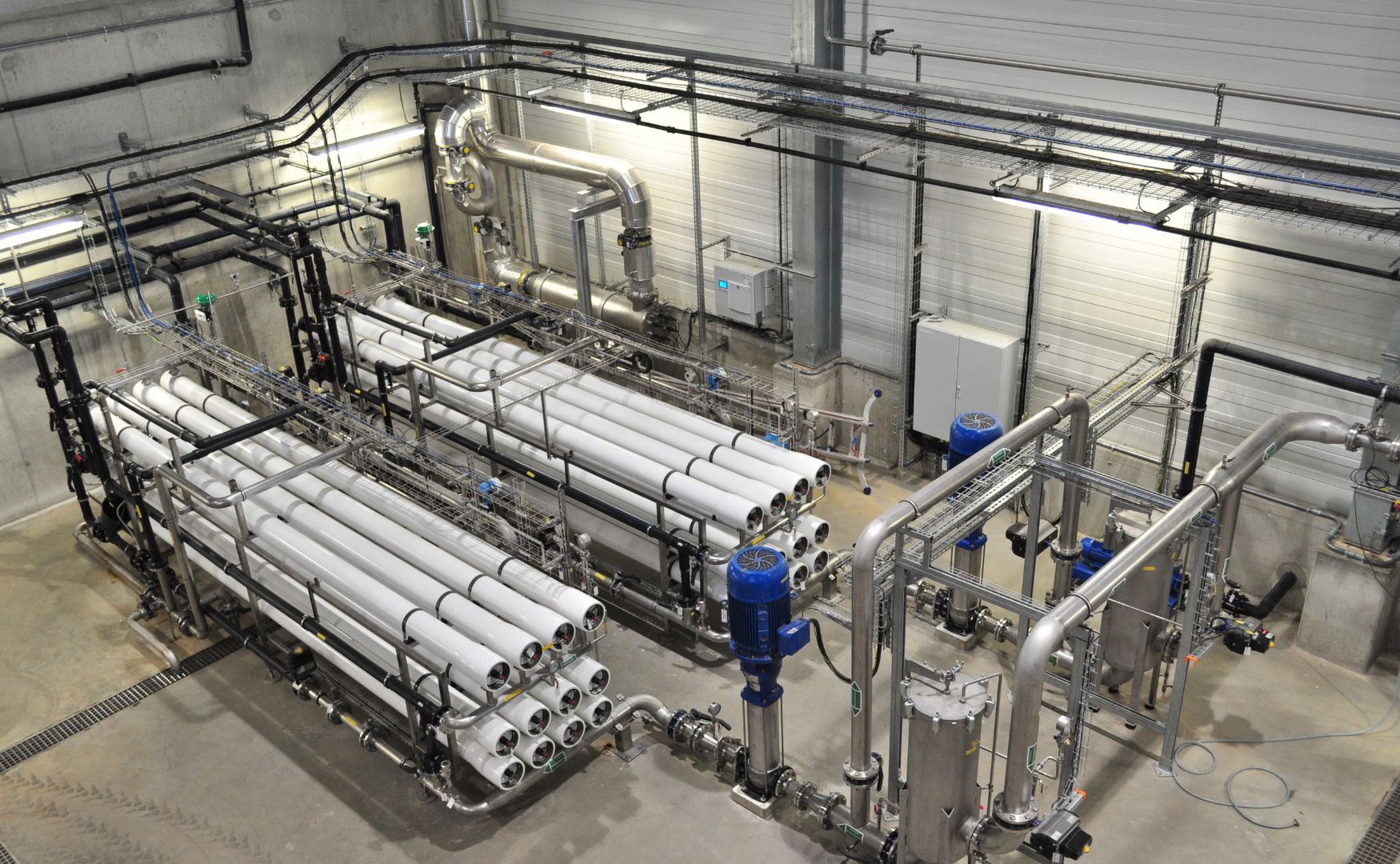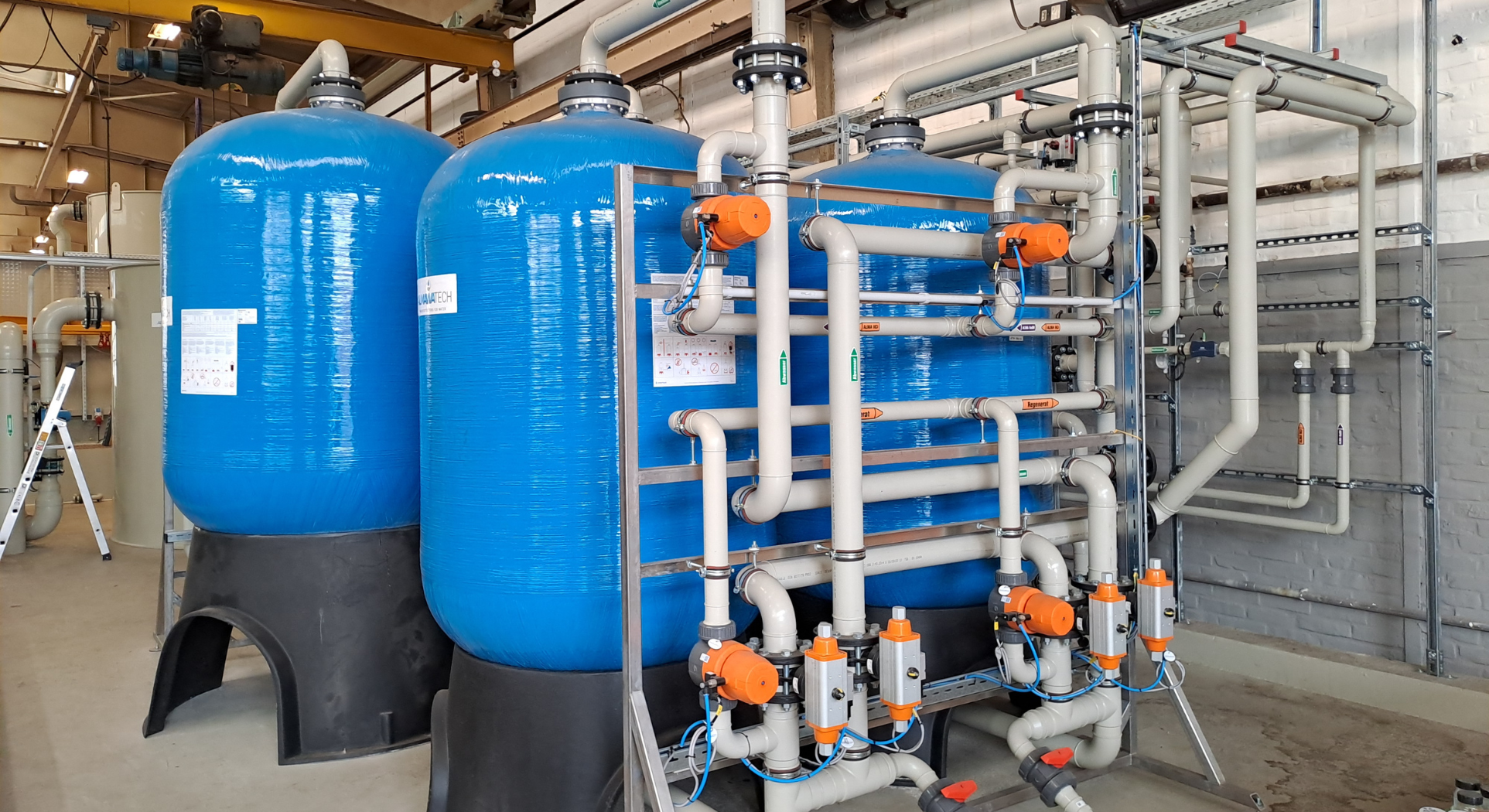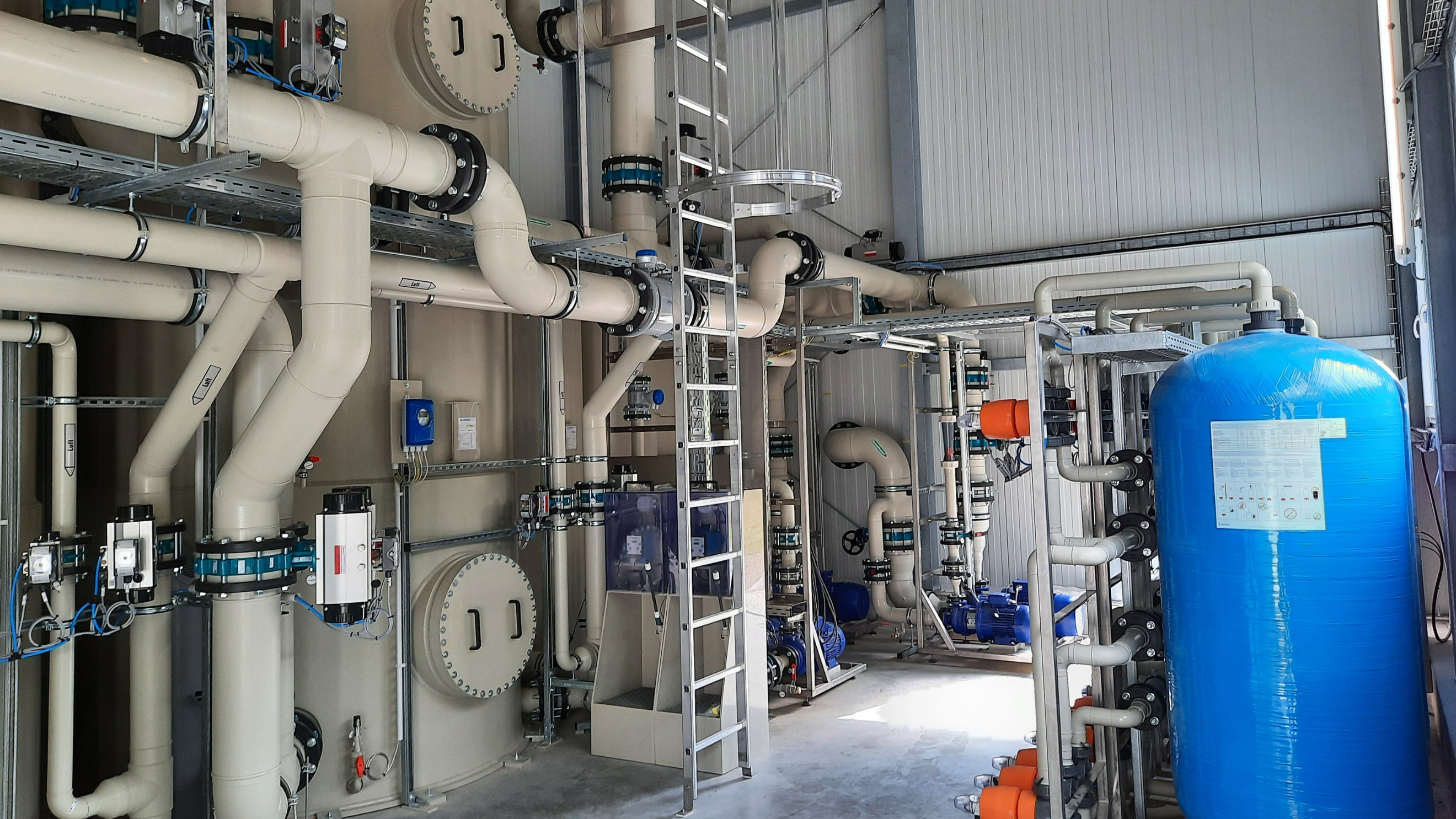Rainwater treatment is an essential process for making rainwater usable for industrial, technical or private applications. It plays a decisive role in industrial water treatment, as it not only conserves resources but also reduces dependence on expensive fresh water sources. Different rainwater treatment processes are used depending on the intended use and quality requirements.
Table of contents
Rainwater: characteristics and challenges
Properties of rainwater
Rainwater is relatively pure in its natural state, as it is produced by condensation from the atmosphere. However, it contains impurities that are absorbed during collection or on contact with surfaces such as roofs, roads or industrial plants:
- Typical impurities:
- Organic substances: leaf residues, pollen, oils and fats.
- Heavy metals: zinc, copper or lead from gutters and roof surfaces.
- Fine particles: Sand, dust or sediment.
- Nutrients: Nitrate and phosphate from atmospheric inputs.
- Microorganisms: germs that are introduced from surfaces.
Challenges during preparation
The composition of rainwater depends heavily on the source and the surrounding conditions. Rainwater from industrial areas often contains pollutants such as oils or heavy metals, while rainwater from roof areas is comparatively less contaminated. This variability places high demands on the selection and combination of treatment processes.
Objectives of rainwater treatment
The requirements for the quality of the treated rainwater determine the choice of technologies. Typical applications are
- Technical applications:
- Cooling water, process water or cleaning water.
- Drinking water quality:
- In regions with water shortages, rainwater is treated to drinking water quality using complex processes.
- Environmental requirements:
- Treatment and recycling of polluted rainwater to minimize discharge into water bodies.
Process for rainwater treatment
Rainwater treatment processes range from mechanical pre-treatment to highly developed chemical, physical and biological processes. The choice of process depends on the quality of the raw water and the requirements for the final water.
1. multi-layer filter with PAC or iron dosing
Multi-layer filters consist of different filter layers (e.g. sand, anthracite, gravel) and are often used in combination with the dosing of precipitants to remove particles, organic substances and heavy metals.
How it works:
- Iron dosage:
- Iron(III) salts (e.g. FeCl₃) are dosed to remove phosphates and very fine particles by precipitation.
- The flocs formed are retained in the filter layers.
- PAC (polyaluminum chloride):
- PAC is used as a precipitant to remove fine particles and dissolved organic compounds by coagulation and flocculation. These flocs are then retained in multi-layer filters.
- Iron dosage:
Application:
- Pre-treatment for subsequent processes such as ultrafiltration or reverse osmosis.
- Direct use for service water (e.g. irrigation or cleaning).
Advantages:
- Cost-efficient for large-volume pre-treatment.
- Removes both suspended solids and dissolved organic compounds.

Photo: Our ALMA FIL multi-layer filter as a pendulum system with PAC dosing
2. ultrafiltration (UF)
The ultrafiltration is a membrane-based process that effectively removes particles, bacteria and viruses. It is often used as an intermediate step in the production of high-purity water.
How it works:
- Water is forced under pressure through membranes with pore sizes of 0.01-0.1 µm.
- Particles, germs and larger molecules remain behind, while water and dissolved salts pass through.
Application:
- Treatment of slightly to moderately contaminated rainwater for technical purposes.
- Preliminary stage for reverse osmosis in the production of drinking or ultrapure water.
Advantages:
- High filtration performance for biological impurities.
- Continuous operation with low maintenance.
3. reverse osmosis (RO)
The reverse osmosis is a pressure-driven process that removes almost all dissolved substances, including salts, heavy metals and organic compounds.
How it works:
- Water is pressed through a semi-permeable membrane under high pressure (5-30 bar).
- Dissolved substances and impurities remain on the concentrate side, while almost pure water is obtained on the permeate side.
Application:
- Production of drinking water from rainwater.
- Production of process water with high purity, e.g. for the electronics or pharmaceutical industry.
Advantages:
- Very high retention rate for impurities (up to 99 %).
- Production of water with extremely low conductivity.
Disadvantages:
- High energy consumption.
- Regular cleaning of the membranes required (CIP - Clean-in-Place).

Photo: Our ALMA OSMO reverse osmosis system for the production of deionized water and for water recycling applications
4. ion exchanger
Ion exchanger systems specifically remove dissolved ions such as calcium, magnesium or heavy metals and are used in rainwater treatment for softening or desalination.
How it works:
- Dissolved cations and anions are exchanged for hydrogen ions (H⁺) or hydroxide ions (OH-) using specific resins.
- Once the resins are saturated, they are regenerated with chemicals (e.g. NaOH or HCl).
Application:
- Production of deionized water (demineralized water) for technical applications.
- Removal of heavy metals from contaminated rainwater.
Advantages:
- High selectivity for specific ions.
- Can be combined with other processes such as reverse osmosis.

Photo: Our ALMA ION ion exchanger system with upstream ALMA FIL AK activated carbon filter
5. biofiltration for organically contaminated rainwater
The biofiltration uses microbiological processes to break down organic compounds in rainwater. It is particularly effective for pollution caused by organic substances that originate from precipitation surfaces such as roofs or roads.
How it works:
- Microorganisms on filter materials metabolize organic substances.
- Oxygen is provided by aeration or natural diffusion.
Application:
- Treatment of rainwater from urban or industrial areas with high organic loads.
- Pre-treatment for downstream reverse osmosis systems.
Advantages:
- Sustainable and cost-efficient technology.
- Reduction of biofouling in downstream membrane systems.

Photo: Our ALMA BioFil Compact biofiltration system for removing residual organic contamination upstream of reverse osmosis systems
Quality requirements for the industrial use of treated rainwater
The industrial use of rainwater as a resource requires precise adaptation of the treatment processes to the specific requirements of the respective application. The quality and purity of the treated water are crucial for ensuring the functionality and efficiency of industrial processes, reducing operating costs and extending the service life of systems. Depending on the application, the requirements vary from moderate to very high - from cooling water and cleaning processes to demanding applications such as process water and steam boiler water.
1. rainwater treatment for cooling water
Quality requirements: Cooling water is an essential component of many industrial processes, particularly in metal processing, power generation and chemical plants. The water quality directly influences the efficiency of heat exchangers and cooling systems.
Low solids content:
- Suspended matter and sediment can cause deposits in heat exchangers and pipes. Deposits reduce heat transfer and increase energy and maintenance costs.
- Zielwert: Trübung < 5–10 NTU.
Conductance:
- The conductance indicates the concentration of dissolved salts in the water and is a decisive parameter for avoiding scaling (deposits) and ensuring the efficiency of heat exchangers.
- Zielwert: Leitwert < 150 µS/cm.
Hardness and hardeners:
- High concentrations of calcium and magnesium promote limescale deposits in pipes and heat exchangers, which reduces heat transfer and increases energy consumption.
- Zielwerte: Gesamthärte < 0,5 °dH, Calciumgehalt < 2 mg/L.
Minimal organic load:
- Organic substances promote the growth of biofilms, which lead to biofouling and impair the efficiency of cooling circuits.
- Zielwert: TOC (Total Organic Carbon) < 10 mg/L.
Stable pH value and corrosion protection:
- A controlled pH value prevents corrosion on metallic components. In closed circuits, the water should also be free of aggressive ions such as chloride and sulphate.
- Zielwerte: pH 6,5–8,5, Chlorid < 50 mg/L, Sulfat < 50 mg/L.
2. rainwater treatment for cleaning processes
Quality requirements: Cleaning processes in the food industry, automotive production or pharmaceutical industry require water with specific purity requirements in order to efficiently clean machines, systems or workpieces without leaving any residue.
Free from suspended matter and particles:
- Particle residues can damage surfaces or reduce cleaning performance.
- Zielwert: Partikelgröße < 5 µm, Trübung < 1 NTU.
Organic purity:
- Organic impurities can leave residues on surfaces and impair hygiene.
- Zielwert: TOC < 5 mg/L.
Hardness-free water:
- For sensitive applications such as rinsing workpieces, the water must be limescale-free to avoid limescale stains.
- Zielwerte: Gesamthärte < 0,5 °dH, Calcium < 2 mg/L.
Sterility (if necessary):
- In hygienically sensitive industries, such as the pharmaceutical and food industries, water must be germ-free to prevent contamination.
- Zielwert: Keimzahl < 10 KBE/mL.
3. rainwater treatment for process water
Quality requirements: Process water is used directly in industrial manufacturing processes, e.g. in chemical production, textile manufacturing or semiconductor production. Here, high water purity requirements are essential to ensure chemical reactions, product quality and system reliability.
Low conductivity:
- Dissolved salts can disrupt chemical processes or cause deposits on surfaces.
- Zielwert: Leitfähigkeit < 50 µS/cm.
Free from heavy metals and specific ions:
- Heavy metals such as iron, copper or zinc can poison catalysts or inhibit reactions.
- Zielwert: Schwermetallgehalt < 0,1 mg/L.
Organic and microbial purity:
- Organic substances and microorganisms must not leave any impurities in the end product or in the production facilities.
- Zielwert: TOC < 2 mg/L, Keimzahl < 1 KBE/mL.
4. rainwater treatment for steam boiler water
Quality requirements: Water quality is crucial in steam boiler systems, as deposits and corrosion caused by even the slightest impurities can lead to significant efficiency losses and damage. Rainwater must be brought to the highest standards of purity.
Extremely low conductivity:
- Dissolved salts and ions must be removed to prevent scaling in boilers and turbines.
- Zielwert: Leitfähigkeit < 0,1 µS/cm.
Oxygen-free:
- Dissolved oxygen must be removed to prevent corrosion on boiler walls and pipes.
- Zielwert: Gelöster Sauerstoff < 10 µg/L.
Free from hardening agents:
- Calcium and magnesium must not be present, as they form deposits in boilers.
- Zielwert: Gesamthärte < 0,01 °dH.
Conclusion
Rainwater treatment offers a wide range of options for using rainwater, but is heavily dependent on the specific requirements of the application. Processes such as multi-layer filters with PAC or iron(III) chloride, ultrafiltration, reverse osmosis, ion exchangers and biofiltration make it possible to treat rainwater efficiently and in a resource-saving manner. A careful analysis of the raw water quality and the desired purity of the final water is crucial for the selection and combination of processes. In this way, rainwater treatment not only helps to conserve resources, but also to reduce costs and comply with environmental regulations.
For further information on our products, please feel free to contact us at any time!







